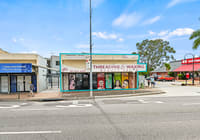
Small projects are some of the most experimental in Australian architecture competitions
Perth Zoo reopens this week and should any tourists who have crossed on the ferry from the city to South Perth to visit find the wind, rain or sunshine a bit much, they can now take temporary refuge under the belly of a giant numbat.
Or maybe they would prefer to shelter beneath a nine-metre-high frilled-neck lizard?
In Melbourne’s south-eastern and impressively renewing suburb of Dandenong, if walkers transiting the City Park find themselves caught short, they can now nip into a stylish new public amenity block inside an incised concrete cone that’s been shaped to reference the red gums that once forested a floodplain.
BKK Architects responded to a commission for a “graffiti-resistant, visually-delightful, way-finding” element of infrastructure by making a public convenience block look like a stylised stump.
In the grounds of the Australian War Memorial in Canberra, Melbourne’s Edition Office, in collaboration with Indigenous artist Daniel Boyd, designed a permanent monument to commemorate the Aboriginal and Torres Strait Islanders who served with Australia’s military forces.
With one facade made of hundreds of small mirror discs that reflect the visitor, a sacred fire inside an 11-metre diameter circle of stone, and a dark, rammed-earth, semi-circular rear wall, through the extreme simplicity of its form the memorial has become a powerful new presence in the sculpture garden.
Another Edition Office installation, but this one a temporary architectural commission for the National Gallery of Victoria, demonstrates why a boutique practice ever mindful that architecture is one of the high arts has come to such national and international prominence in the past few years.
The hollow black, nine-metre high split tower within which small, black, blown-glass shapes by Indigenous artist Yhonnie Scarse glitter and suggest murnong daisy tubers, is called “In Absence”.
The architects say to visually evoke “the false absence” of the terra nullius – or the empty land premise of Australia’s foundation – the structure in the NGV garden that is “just enough architecture” is “a fissure, a void … a building designed to evoke absence”.
These four imaginative creations all come from the Small Projects division that could be presumed to be one of the incidental categories of the annual awards system of the various state and territory chapters of the Australian Institute of Architects that are beginning in digital form this week (ACT), and that will continue through to July 19 (Queensland).
Scores of incredibly diverse, minor-scale, smallish-budget projects come through in the shortlists in each state. Yet they can often amount to the most free-form and experimental of all the structural design categories – even if they are toilet blocks, which is a more common architectural commission than you might presume.
The state award winners will go through to compete in the national awards that are held each November.
Back at the South Perth foreshore on which the City of South Perth has recently lavished $7.5 million to make it more attractive and accommodating for locals and the (normal year) 700,000-plus annual zoo visitors, the now iconic animal and reptile-shaped canopies that resulted from a collaboration by Place Laboratory and Iredale Pedersen Hook Architects have already warranted international interest.
Only a week ago IPH was discussing them in an online World Architectural Festival forum. In the shortlists of the 2020 WA architectural awards, they are contending in three categories: small projects, lighting and the Dulux Colour Award.
Made from plate aluminium, they arose from a commission for sheltering canopies that Adrian Iredale says were wanted as placemarkers and “as a bit of fun that would engage with kids who pile off the ferries and need somewhere to stand before they go to the zoo”.
IPH, which has continued a 22-year relationship working on various infrastructure projects for the zoo, suggested representing the endangered WA mammal, the numbat, and the frilled-neck lizard in giant form “and we got so much love and support for it”.
Iredale says by fabricating them using origami techniques allowed the aluminium to be folded for easier construction. “In that process, the animals ended up being quite abstract.”
The creatures are visible from Perth’s CBD, an eight-minute ride across the water, and the architect says “we didn’t set out to create icons, we meant them to be subtle”. But at such scale and “in such a beautiful place”, when they went up in October last year, they became instant landmarks.










